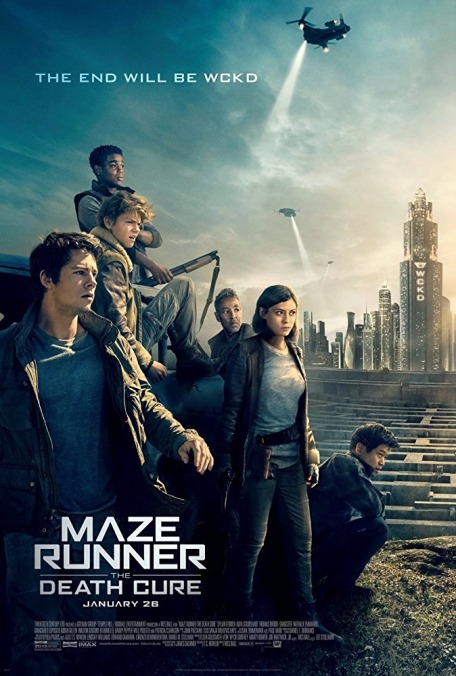The Maze Runner series makes an exit with the proficient, energetic sci-fi junk of The Death Cure

No one creates a film series hoping to become the overlooked middle child of an entire subgenre. With that in mind, it’s possible to generate just a smack of sympathy for The Maze Runner and its two sequels. These adaptations of a dystopian YA book series haven’t hit the blockbuster heights of The Hunger Games or Twilight, nor have they immediately imploded like so many Cities Of Bones before them. They haven’t even experienced Divergent-style flameout, where initial success gave way as audiences and vastly overqualified actors headed for the exit, leaving a series hilariously unfinished.
As it turns out, with hardly anyone outside of hardcore Maze Runner fans (and however many supplemental moviegoers it takes to get within range of $100 million domestic) paying attention, the runty little brother of The Hunger Games has gotten surprisingly proficient in that area of well-produced sci-fi junk where a lot of the dialogue consists of variations on, “Go, go, go!” Maze Runner: The Death Cure—being the continuing adventures of Thomas (Dylan O’Brien) and a ragtag group of young adults who have been subjected to sinister experiments involving their immunity to a world-ravaging zombie plague—caps the trilogy in peak form. For this series, that means it’s watchable, often surprisingly fun, and largely devoid of personality.
In the first film, Thomas, along with Newt (Thomas Brodie-Sangster), Teresa (Kaya Scodelario), Minho (Ki Hong Lee) and some nondescript others, were trapped in a walled compound outfitted with a perilous maze; in the sequel, The Scorch Trials, they broke out and rebelled against WCKD, the organization that held them prisoner in search of a self-serving plague vaccine. The Death Cure picks up about half a year later, with Thomas leading some of his old friends on a rescue mission to retrieve their captured buddy Minho—and, he secretly hopes, Teresa, who has betrayed her friends and joined up with WCKD’s Ava Paige (Patricia Clarkson) to pursue further research. Without Teresa around, Scorch Trials newbie Brenda (Rosa Salazar) has officially been promoted to Only Girl duties.
The opening action sequence, a train attack reminiscent of moments from Fast Five and Mad Max: Fury Road, is very much in the spirit of this newest and improved Maze Runner: fast-paced, heavily indebted to other and better movies, and pretty enjoyable. Wes Ball, who has directed all three Maze Runner pictures and zero other features, knows when to keep his camera running, rather than cutting. He has a knack for propulsion, and so the action never feels like a hash of bullets, broken glass, and fire. Even more so than the Screen Gems-like Divergents, this series has come to resemble a junior-varsity Resident Evil, with its zombies, science labs, sinister corporations, and stories heavy on running, capturing, and breaking in. One main difference is that the zombie slayings, impromptu tracking-device-removal surgeries, and straight-up gunshot wounds are, in this PG-13 universe, as close to bloodless as possible.
The other main difference is the lack of an action star like Milla Jovovich. Imagine how well the Maze Runner movies would play with interesting characters! O’Brien’s Thomas remains an earnest, humorless blank; other characters keep saying his name so the audience doesn’t forget who the hell he is (in the process, they wind up sounding like a particular bad Kristen Wiig sketch from SNL), and eventually the movie has to fall back on the old YA trope of insisting upon his extra-specialness as a reason to find him noble or endearing. Salazar and Giancarlo Esposito (playing her father figure) make more compelling action figures; they don’t have much depth, but they seem to be having fun, and Salazar gets behind the wheel for a particularly neat bus-driven bit, which also features a series rarity in the form of an actual sight gag.
As the rebels attempt to sneak into the walled-off city where WCKD has its headquarters, the movie uses up a lot of energy getting its character into close scrapes, then flicks on the autopilot to get them out; Ball and regular writer T.S. Nowlin are shamelessly reliant on last-second rescues from characters who have been off-screen for five or 10 minutes. Any loftier sci-fi ideas get lost in plot details that have been made murky in the name of suspense. It’s somewhat compelling to watch Scodelario’s Teresa make a convincing justification for siding with the supposed bad guys, but any attempts at nuance tend to raise further questions: If WCKD is so desperate to engineer a zombie cure, even for selfish reasons, why aren’t they more open to negotiation with people who might hold the key to one, or willing to perform experiments with less torture? (Maybe they were serious about that evil-sounding acronym.) And how exactly do the scrappy rebels want to address the zombie plague without a cure, besides crossing their fingers and hoping more of them don’t get turned into zombies?
The Death Cure lacks the elemental, Twilight Zone-ish simplicity of the original film, but Ball has never really made that delicate quality work anyway. He’s better at hunting his characters through mad sprints and sloppy vehicle chases. His pacing casually unites a number of disparate elements: a noseless Walton Goggins; an ineffective border wall; the former little kid from Love Actually; a love story so perfunctory that it’s almost respectable. If only he could’ve kept the movie from running an almost unconscionable 140 minutes. Still, even this bloat hints that maybe The Maze Runner understands its place in the YA universe. There will be no splitting of the third book into two equally hobbled films. The Death Cure turns out to be a perfect title: It fixes some of the series’ ills, but part of the relief comes from it finally ending.